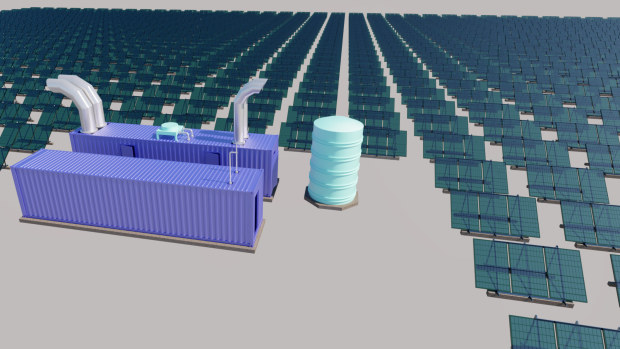$15b NT hydrogen project to suck water from air

A $US10.75 billion ($15 billion) green hydrogen project in the Northern Territory will use novel technology intended to beat the problem of scarce water plaguing similar renewables-based projects as it targets exports as early as 2027.
The Desert Bloom Hydrogen project by technology company Aqua Aerem – literally “water from air” –, will use “breakthrough atmospheric water capture technology”, powered by the rich solar resources of the Barkly region to produce commercial quantities of renewable hydrogen.

The off-grid project will not impact the availability of water for community or agricultural use.
After nine months of trials at a pilot project at Tennant Creek, the venture is moving to construction, with initial hydrogen production anticipated in 2023 to be sold in the local market.
The technology works by capturing water from the atmosphere in arid environments, using a process used by atmospheric water generators that can be found in offices to produce drinking water, but assisted by the use of an absorbent.
“That allows us to really turbo-charge the process and be able to capture quite significant volumes of water,” Aqua Aerem co-founder and CEO Gerard Reiter told The Australian Financial Review.
Green hydrogen projects use renewable energy to split water into hydrogen and oxygen.
Mr Reiter expects the project to be Australia’s first to be producing green hydrogen at less than $US2 a kilogram, still a step away from the federal government’s stretch target of green hydrogen supply for less than $2/kg.
Capital for the project, which has been granted “major project status” by the NT government, is initially being provided by Sanguine Impact Investment.
However, “one of Japan’s largest gas buyers and distributors” has agreed to invest in it, Aqua Aerem said, without yet revealing the name. NT utility Territory Generation has meanwhile signed a deal to buy hydrogen from the initial project.
Sanguine Impact Investment, an investment firm focusing on infrastructure in emerging markets and developing economies is majority owner of Aqua Aerem, which also involves the original proponents of the project, infrastructure adviser Axcentium and intellectual property specialist Ahurei.
The project is one of a flood of ambitious green hydrogen export ventures in planning as energy suppliers, technology companies, infrastructure investors and others seek to tap Australia’s huge renewable energy resources to produce a clean fuel expected to be key to decarbonising heavy transport, industry and power generation.
Projects have been announced recently by trading giant Trafigura, Fortescue Metals, AGL Energy, Macquarie Group, Jemena, and Woodside Petroleum, while BP, Origin Energy and others also have developments in the works.
Separately on Monday, start-up Port Anthony Renewables said it completed a “heavily oversubscribed” $3 million pre-IPO capital raising as it prepares to develop what it said would be the largest hydrogen hub in south-eastern Australia. It is targeting a listing on the ASX in the June quarter of 2022.
Meanwhile, in a sign of the emergence of hydrogen in the transport sector, Aurizon and Anglo American agreed to study the use of hydrogen-powered trains for bulk freight. If successful, the two could go on to develop a prototype hydrogen-fuelled, heavy-haul locomotive that could be used on coal rail systems to Gladstone and Townsville ports.
The federal government’s State of Hydrogen report released last Friday pointed to several challenges facing Australia’s sector as it attempts to become a world-leading exporter of hydrogen, including building demand, achieving low-cost production at scale and reducing deliver costs.
Mr Reiter said the Desert Bloom project differed from many other proposals in that it is targeting financial close on the first, $600 million phase in early 2022. Initial production is expected to be about 2500 kg/day, rising to about 35,000 kg/day, before moving to the second, export-oriented stage involving up to 410,000 tonnes a year.
The energy would most likely be shipped overseas as compressed hydrogen and liquid ammonia or as liquid methylcyclohexane, as favoured by Japanese buyers, which can be transported using conventional petroleum tankers, he said.
The NT government said the Desert Bloom project could create more than 1000 full-time construction jobs at its peak and more than 120 ongoing full-time jobs once it is operational.
It said the next steps include the NT government working with the venture to identify suitable land in central Australia to harness solar energy.
“With one of the best solar resources in the world – and the development of projects like Desert Bloom – the Territory will play a leading role in the emerging renewable hydrogen market,” NT Chief Minister Michael Gunner said.
Subscribe to gift this article
Gift 5 articles to anyone you choose each month when you subscribe.
Subscribe nowAlready a subscriber?
Introducing your Newsfeed
Follow the topics, people and companies that matter to you.
Find out moreRead More
Latest In Energy
Fetching latest articles